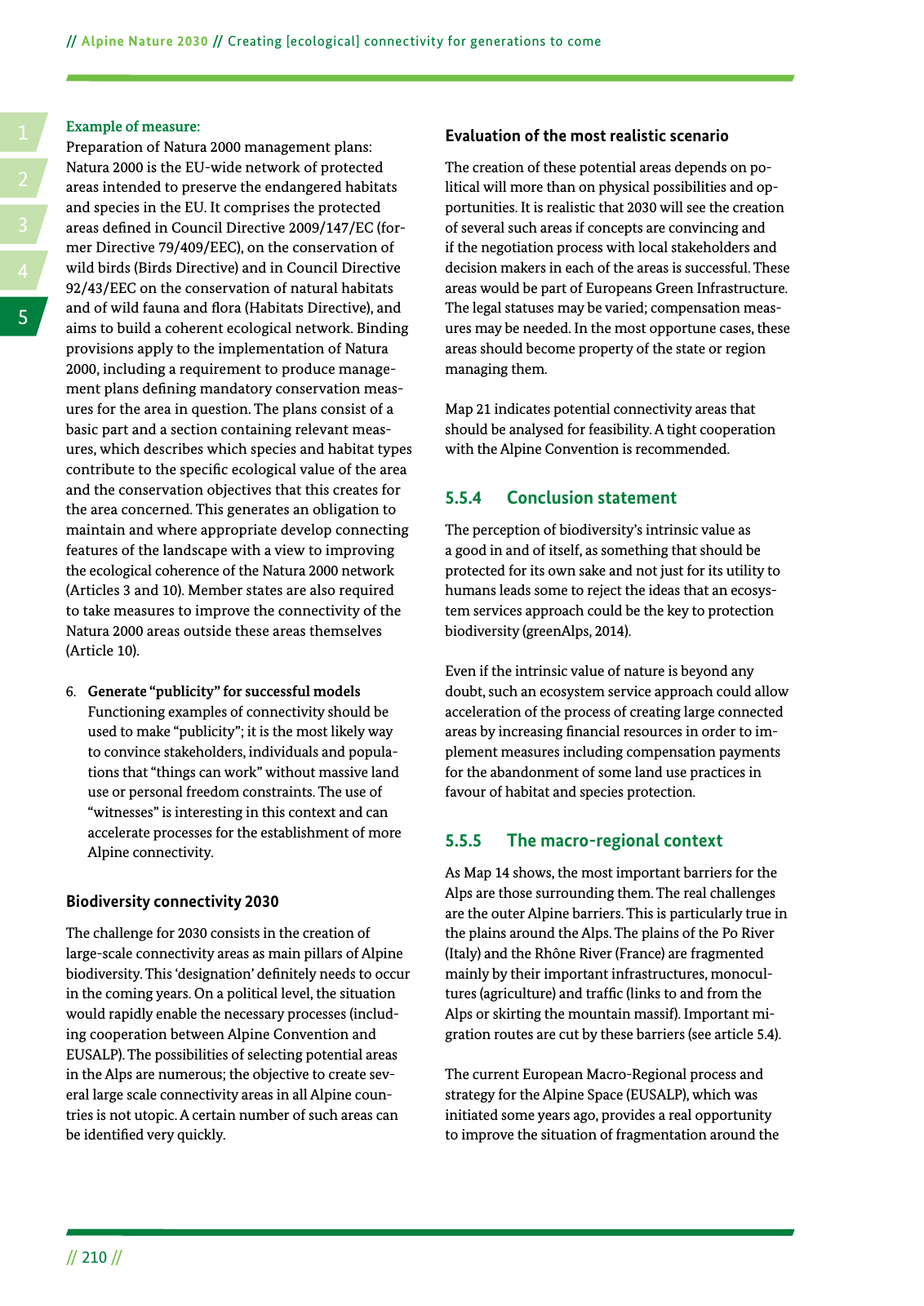14 2 5 3 Alpine Nature 2030 Creating ecological connectivity for generations to come 210 Example of measure Preparation of Natura 2000 management plans Natura 2000 is the EU wide network of protected areas intended to preserve the endangered habitats and species in the EU It comprises the protected areas de ned in Council Directive 2009 147 EC for mer Directive 79 409 EEC on the conservation of wild birds Birds Directive and in Council Directive 92 43 EEC on the conservation of natural habitats and of wild fauna and ora Habitats Directive and aims to build a coherent ecological network Binding provisions apply to the implementation of Natura 2000 including a requirement to produce manage ment plans de ning mandatory conservation meas ures for the area in question The plans consist of a basic part and a section containing relevant meas ures which describes which species and habitat types contribute to the speci c ecological value of the area and the conservation objectives that this creates for the area concerned This generates an obligation to maintain and where appropriate develop connecting features of the landscape with a view to improving the ecological coherence of the Natura 2000 network Articles 3 and 10 Member states are also required to take measures to improve the connectivity of the Natura 2000 areas outside these areas themselves Article 10 6 Generate publicity for successful models Functioning examples of connectivity should be used to make publicity it is the most likely way to convince stakeholders individuals and popula tions that things can work without massive land use or personal freedom constraints The use of witnesses is interesting in this context and can accelerate processes for the establishment of more Alpine connectivity Biodiversity connectivity 2030 The challenge for 2030 consists in the creation of large scale connectivity areas as main pillars of Alpine biodiversity This designation de nitely needs to occur in the coming years On a political level the situation would rapidly enable the necessary processes includ ing cooperation between Alpine Convention and EUSALP The possibilities of selecting potential areas in the Alps are numerous the objective to create sev eral large scale connectivity areas in all Alpine coun tries is not utopic A certain number of such areas can be identi ed very quickly Evaluation of the most realistic scenario The creation of these potential areas depends on po litical will more than on physical possibilities and op portunities It is realistic that 2030 will see the creation of several such areas if concepts are convincing and if the negotiation process with local stakeholders and decision makers in each of the areas is successful These areas would be part of Europeans Green Infrastructure The legal statuses may be varied compensation meas ures may be needed In the most opportune cases these areas should become property of the state or region managing them Map 21 indicates potential connectivity areas that should be analysed for feasibility A tight cooperation with the Alpine Convention is recommended 5 5 4 Conclusion statement The perception of biodiversity s intrinsic value as a good in and of itself as something that should be protected for its own sake and not just for its utility to humans leads some to reject the ideas that an ecosys tem services approach could be the key to protection biodiversity greenAlps 2014 Even if the intrinsic value of nature is beyond any doubt such an ecosystem service approach could allow acceleration of the process of creating large connected areas by increasing nancial resources in order to im plement measures including compensation payments for the abandonment of some land use practices in favour of habitat and species protection 5 5 5 The macro regional context As Map 14 shows the most important barriers for the Alps are those surrounding them The real challenges are the outer Alpine barriers This is particularly true in the plains around the Alps The plains of the Po River Italy and the Rhône River France are fragmented mainly by their important infrastructures monocul tures agriculture and traf c links to and from the Alps or skirting the mountain massif Important mi gration routes are cut by these barriers see article 5 4 The current European Macro Regional process and strategy for the Alpine Space EUSALP which was initiated some years ago provides a real opportunity to improve the situation of fragmentation around the

Hinweis: Dies ist eine maschinenlesbare No-Flash Ansicht.
Klicken Sie hier um zur Online-Version zu gelangen.
Klicken Sie hier um zur Online-Version zu gelangen.